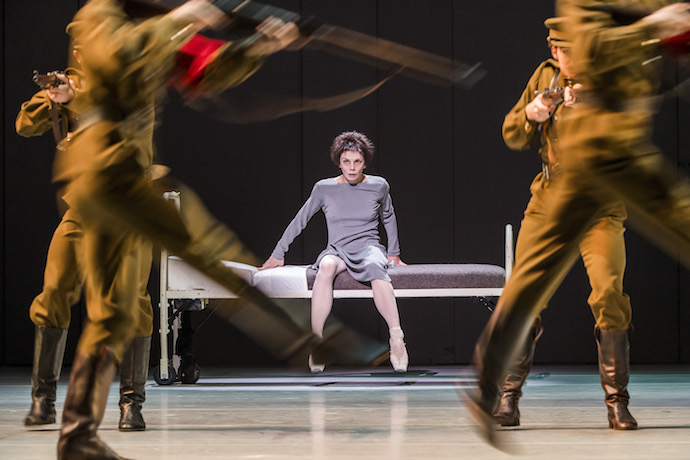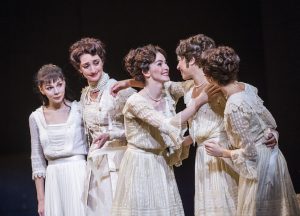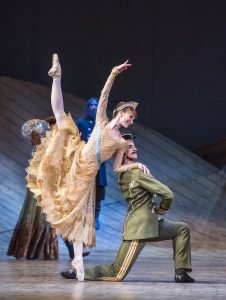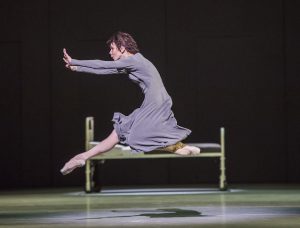
Natalia Osipova as Anastasia. Photo: Tristram Kenton
Royal Opera House, London
By Sarah Kirkup
It’s a compelling story that bears all the hallmarks of a fictitious blockbuster. But the events framing the massacre of Tsar Nicholas II and his family in 1918 and the subsequent ‘reappearance’ of his youngest daughter Anastasia cannot be so neatly packaged. And neither, it seems, can Kenneth MacMillan’s eponymous ballet – returning to the Royal Ballet for the first time in twelve years – which seems to ask more questions than it answers.
MacMillan created Anastasia in the summer of 1967 while he was Director of the Deutsche Opera Ballet. He had long been drawn to the scandal surrounding Anna Anderson, a woman who in 1920 tried to commit suicide by jumping into a canal in Berlin. Refusing to speak, the 24-year-old was taken to a nearby psychiatric hospital, where she became known as ‘Miss Unknown’. Eighteen months later, rumours began to circulate that one of the Romanov daughters had survived the murder of the Imperial family in Ekaterinburg. Was Miss Unknown in fact Anastasia?
When MacMillan created the ballet, nobody could be absolutely sure that she wasn’t. It was only in 1994, two years after the choreographer’s death, that DNA tests proved Anna Anderson was in fact a Polish peasant who had travelled to Berlin to pursue an acting career. But regardless of the outcome, this tale of loss, intrigue and mistaken identity resonated strongly with MacMillan, who was – by his own admission – often drawn to the concept of ‘the outsider’ in his work. When the one-act ballet was premiered in West Berlin, critics labelled it ‘bold’ and ‘daring’. Set in a mental hospital, it opens with disconcerting electronic music and leads into the otherworldly Fantaisies Symphoniques by Martinů as Anna struggles to recall who she is.
Nearly 50 years later, Anastasia still has the ability to shock, as demonstrated by the Royal Ballet’s current production. Natalia Osipova is mesmerising in the title role, and the set by Bob Crowley, designed for a new production created in 1996 and featuring a lone hospital bed, eerily lit and centre stage, is appropriately stark. But the problem is that we have to get through Acts I and II first. Early in his tenure as Director of the Royal Ballet, MacMillan expanded Anastasia into a three-act work, with the original ballet serving as the finale, in a bid to explore the backstory of Anastasia and, at the same time, to create performance opportunities for the entire company. Does it all hang together? Yes and no.

Anastasia, her mother and sisters. Photo: Tristram Kenton
We begin on board the imperial yacht in 1914, where the Romanov family, together with their trusted friend Rasputin and a group of naval officers, are enjoying a picnic. We witness the bond between Anastasia, a playful, fleet-footed Osipova, and her sisters – Olivia Cowley as Olga is particularly entrancing – and their protectiveness towards their haemophilia-stricken brother Alexey (an affecting Rory Toms). We are also privy to a seemingly close relationship between the Tsar and the Tsarina (a poised, elegant Christina Arestis). Rasputin (Thiago Soares) lurks in the background, a lingering sinister presence. There are excellent, technically demanding solos from the officers (Ryoichi Hirano, Valeri Hristov, Alexander Campbell) and high-octane performances from the three bathers (Luca Acri, Tristan Dyer, Marcelino Sambé). The brilliant Edward Watson, another officer, is underused here (so, sadly, is Soares). The music, Tchaikovky’s First Symphony, adds an appropriately exuberant Russian flair, and MacMillan’s steps mould into the musical phrases. But where are the expressive limbs and emotional abandon we’ve come to associate with this choreographer? This is neoclassical MacMillan, surprisingly restrained but beautifully danced by the Royal Ballet.

A Scene from Act II of ‘Anastasia’. Photo: Tristram Kenton
The setting for Act II is a lavish ballroom, dominated by Crowley’s deliberately off-kilter chandeliers. It’s March 1917, and we’re in Petrograd, celebrating Anastasia’s ‘coming out’ into society. The music is now Tchaikovsky’s dance-filled Third Symphony, the perfect accompaniment to the entertainment provided by the Tsar’s favourite ballerina (and ex-lover) and her dancing partner, exquisitely performed by a coquettish Marianela Nuñez and a solid Federico Bonelli. The tension between the Tsar and his jealous wife is palpable. We glimpse revolutionary activity outside the palace walls, and it’s not long before a bloody massacre (admittedly rather lacklustre in this production) destroys the Romanov family and, with it, the Russian Empire.
The distorted electronic music that opens Act III is as startling as the set. Fritz Winckel and Rüdiger Rüfer’s disorientating score, with its repetition of the name Anastasia, echoes and reflects the tormented mind of the dishevelled woman we see before us, as does the bleakness of her surroundings. Osipova is wild-eyed, terror-stricken and utterly lost as she ‘feels’ her way from the hospital bed to the front of the stage, tentatively planting her feet into the ground and beseechingly holding out the palm of her hand to the audience, as if for reassurance of who she is. When she watches some jerky black-and-white footage of the Romanov family alternating with brutal assassination scenes during the Revolution, her memory is suddenly reignited. She recalls her family, her husband, the death of her baby, the murder of her loved ones. What is real, what is imagined? As Martinu’s strident, discordant, emotionally wrought music propels her towards different characters in turn – a ravaged Edward Watson as her husband, a menacing Thiago Soares as Rasputin, her beautiful sisters, her loving parents – it’s difficult to tell. It is as if we, the audience, are inside Anna/Anastasia’s head – and it’s a terrifying place to be.

Natalia Osipova as Anastasia. Photo: Tristram Kenton
Much of this has to do with MacMillan’s mastery of human expression through movement; this woman is unhinged, uncentred, and the choreography he gives her reflects this. Finally, we are seeing the MacMillan we all know and love. But credit, too, should be given to Osipova, who is devastating in her display of emotional vulnerability. When she kicks out at Rasputin, driving him – this dark, ‘evil’ force – away from her and off the stage, we feel her anger and desperation. And when she screams – a wild, animalistic howl – it’s a bone-chilling moment.
Everything we have seen before now has been leading to this point. And the fact that we’ve witnessed Anastasia’s former life in all its opulent glory makes her fall from grace seem all the more poignant. But do we really need the two acts preceding it? Couldn’t her relationships with her family, and her position in society, be conveyed just as effectively in one act? A ballet of two halves would seem more balanced, with the third act feeling less like a separate ballet. As it is, after two acts of neoclassical choreography and Romantic symphonic writing, the raw, expressionist act that follows is almost too much to bear. Then again, perhaps that was exactly MacMillan’s intention. ![]()
There are further performances of Anastasia on 12 November (1.30pm and 7pm); visit roh.org.uk for returns. Anastasia was screened live to cinemas on November 2; for information on future Royal Ballet screenings, visit roh.org.uk/cinemas